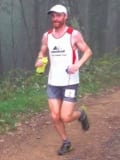For several years now, my running has been largely dictated by the land that I am running upon, and my idea of what running looks like changes drastically depending on where I am living at the time. Over the past couple weeks, though, I have been more distinctly reminded of this then ever before. Having made my summer return to Juneau, Alaska, I have been more aware then ever how different it is to run here than anywhere else I have run before.
I recently completed the first session of my Alaska Mountain Ultra Running Camp, and the one thing I asked of the campers before we went for a single run was to keep a very open mind. What “running” looks like to me here in Juneau isn’t likely to be the same as what running looks like to anyone from anywhere else in the world, nor should it. By the end of the camp I think everyone seemed to have a better sense of this notion. I know that I have come to understand it more than ever before.
To a large degree I think running, and more specifically trail running, should be a celebration of the land in which we choose to run upon, and being that the land varies so greatly from one place to another, it only makes sense that what running looks and feels like should vary greatly depending on where we are.
In its simplest form, I think trail running is nothing more than travelling quickly on foot over land. On flat, smooth land this means we are running quite fast and very evenly paced. On steep, uneven land this might mean we are walking much of the time and covering less than 4 or 5 miles an hour on average. Throw mud, snow, rain, wind, etc into the mix and things become even more varied.
Several years ago, I didn’t accept all of these varieties as running. I tried to find places to run that were generally flat and smooth. If I wasn’t moving at least 6 or 7 miles an hour, I didn’t consider it running. Now, though, I have made a gradual shift in my mindset, and I often go on “runs” in which I’m only actually running 30% (or less) of the time. Is it logical to even call this running? Many would argue that it is not, but I think it all depends on the land you are “running” upon, and it makes the most sense to me to think of running as that which is the most effective way to travel quickly on foot through that land.
Here in Juneau there are numerous routes that would be impossible to do faster than 4 or 5 miles an hour. Many of these routes have long stretches that are slower to run than to walk. When this is the case, I walk, and when it is most effective to run, I run. In the end, I cover a particular route in the manner that is the most efficient way to do so. Some days this means doing 20 miles in a few hours, but more often than not around here, this means covering only 10 or 12 miles in a few hours. In the end, I don’t think of one as more of a run than the other, just two different runs in which I’m moving as effectively as the landscapes allow.
When I first moved here, I didn’t consider many of the local routes as options for running, but as I came to open my mind about what it means to run, I began to discover some of the most scenic, challenging, and enjoyable running I have ever seen, even if much of the time I’m actually walking. To someone who lives in a flat, smooth region of the world it might sound like a very strange thing to walk so much of a “run”, but all we’re really doing when we run fast over flat smooth terrain is the same thing we’re doing when we do a rugged mountain run that takes an hour to cover 3 or 4 miles. In both cases, we’re simply taking what the land offers and pushing ourselves quickly and efficiently over the land. This is something you might want to consider the next time you shy away from running a certain route because it’s too steep, muddy, rugged, or technical that you might not be moving faster than a brisk walk for much of the time. You just might find that this brisk walk is actually a very enjoyable “run.”
[Editor’s Note: If any of you are interested in seeing first hand just what it means to run here in Alaska, Geoff does have a handful of spaces still open for two of the three remaining sessions of the above mentioned Alaska Mountain Ultra Running Camps. He’d love to have the opportunity to show you what it looks like to “run” around here.]
